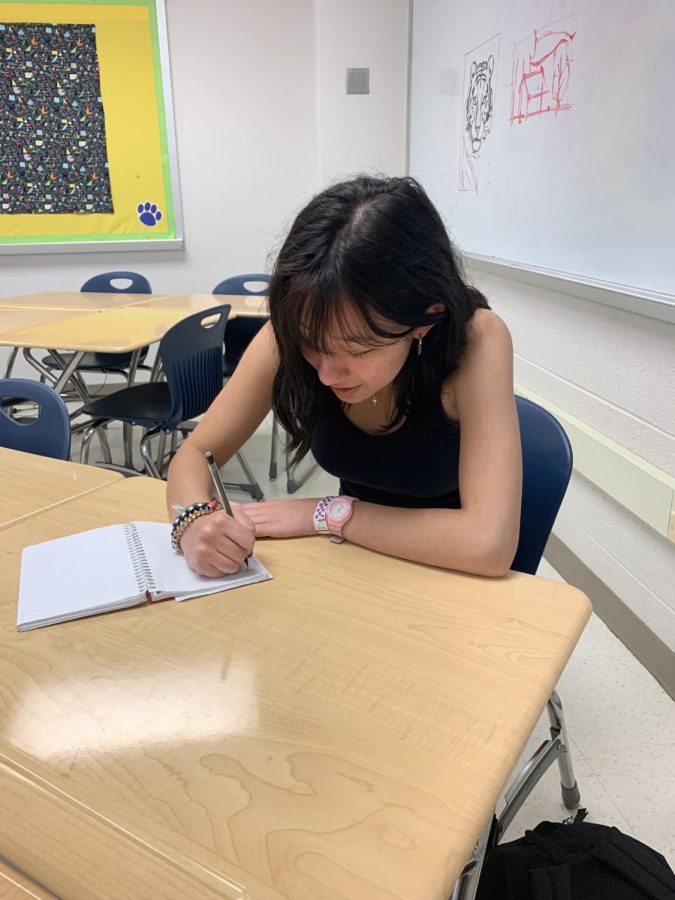Students combat the stigma against mental health
To de-stress and collect her thoughts WCHS senior Sophia Danpino writes in her journal. Journaling as a coping mechanism is a positive outlet for her feelings.
December 2, 2022
Cloudy afternoons, heavy backpacks and late nights chipping farther and farther into sleep. With the knee-deep stresses of the end of the first quarter, these patterns begin to set in. For some, the routine and consistency of the rhythmic nature of school can be comforting. But for others, it can represent anxiousness, negativity and even hopelessness. During these times, students must remind themselves mental health is a priority.
“Mental health is just as important as our physical health, but for years (and still to this day), there is a significant stigma surrounding mental health and mental illness,” WCHS psychologist Lily Braun said.
According to a 2019 study by the Centers for Disease Control, 36.7% of adolescents aged 12-17 felt persistent sadness or hopelessness. In addition to underscoring the alarming prevalence of mental health struggles amongst teenagers, the percentage indicates that action must be taken to promote further discussions about mental health.
“As a junior especially, I feel so overwhelmed by pressures not only from myself and my family but from my peers about the school,” WCHS junior William Wang said.
Chasing deadlines and managing overlapping test schedules in addition to personal and social lives, both online and offline, can leave students with little mental bandwidth to prioritize themselves. This lack of processing time can leave one overwhelmed, ultimately hindering the ability to live meaningfully beyond academics.
“School has picked up recently, and it seems like I have a test every day,” Wang said. “Sometimes I find it hard even to take a moment to process and deal with my stress.”
Going through the day without taking a moment to feel and experience, instead staying on ‘autopilot,’ is an unsustainable strategy for dealing with stress. Though seemingly convenient in the short term, this suppression of emotion can often build and multiply.
“By practicing strategies that promote mental well-being, we are all more available to make healthy choices, overcome challenges, and maintain rewarding and positive relationships,” Braun said.
Often, mindfulness, journaling, practicing gratitude, or other coping strategies can seem irritating and embarrassing to teens. However, finding a suitable mechanism can supersede these stigmatizations, unlocking a window into emotional intelligence and healing.
“Taking the time to socialize with friends, getting enough sleep, eating balanced meals, and participating in fun and relaxing activities are crucial in managing your mood and stress levels,” Braun said.
At WCHS, administrators and teachers allocate an extra five minutes to the second period, a time dedicated to wellness and mindfulness activities. This allocation facilitates an accepting, meaningful conversation about mental health in a school environment.
“The five minutes at the end of class is tedious at times,” Wang said, “but I can see why fully dedicating those five minutes to an outlet for stress, even if it’s only that much for the whole day, is beneficial.”
In addition to creating a safe and accessible environment at WCHS, school-wide measures contribute to the destigmatization of emotional vulnerability and mental health. Including five minutes of wellness time, weekly Bulldog Pride and mental health days as excused absences, these initiatives are beneficial to the way students and staff think about mental health.
“Being vulnerable and sensitive can feel weak, so I have a hard time speaking up about my stress or struggles, and I think a lot of my peers do, too,” Wang said.
Despite the societally instilled repulsion of lowering the emotional guard, opening up to a friend, family member or teacher may be helpful in dealing with emotions. As much as personal mental health should be a priority to each individual student, it is also a priority for teachers, the counseling staff, and other adults in the school building. Above all, reaching out for help in times of need is a sign of strength and courage, not of weakness or shame. Every WCHS student deserves access to the care and attention that they require.



